#dynamic headlight range control
Explore tagged Tumblr posts
Text
What are the best LED lights for cars?
Choosing the "best" LED lights for your vehicle depends largely on your specific goals, vehicle type, and budget. There is no single "best" choice, as the ideal choice varies for headlights, fog lights, interior lights, and more. Here are the best recommendations based on common applications and key factors:
🛑 Key Considerations: First Legality and Safety:
Headlights and fog lights: Your most important consideration. Not all LED bulbs are legal or safe for use in halogen reflector/projector housings. Many LED bulbs create excessive glare, diffuse light, and obscure vision for oncoming vehicles.
Look for SAE/DOT or ECE certified bulbs designed for your housing type (reflector or projector). Reputable brands design their bulbs to mimic the position and beam pattern of a halogen filament. Look for LED bulbs with adjustable light patterns (like SNGL) to avoid glare and dark areas.
WARNING: Avoid cheap, uncertified "plug and play" LED bulbs that claim to be universal. They are often illegal and unsafe.
Quality & Reliability: Prefer brands known for good thermal management (large heat sink, efficient fan or copper base plate, copper tubing), durable components and stable output. Cheap LEDs break easily and can damage wiring.
Compatibility: Must match your bulb size model (H11, 9005, etc.), housing type (reflector/projector - ask your supplier!), and usually CANbus compatible to prevent error messages on modern cars.
🚨 Best LED Headlight Bulbs (Low/High Beam) Prioritize: Legal Beam Pattern Lifespan Brightness Heat Management
Most Recommended Brands/Options:
Brand and Model Key Features Best Use Reasons for Recommendation
🔆 Philips Ultinon Pro9000 Good optics, beam focus, strong heat management Performance- and safety-conscious users are willing to invest OEM-like beam pattern benchmark, ECE certification, excellent manufacturing quality 🔆 SNGL Competitive intelligent IC led driver built-in a all-new CANBUS system, the compatibility performance has been greatly improved, top-notch thermal management (copper substrate, copper tube, fan, heat sink), more reasonable price, adjustable light pattern, no glare and dark areas, DOT compliant. 🔆 Beamtech Pro Projector Housing Very popular, solid performer Budget-focused projector headlights Great value, generally good in projectors, good heat dissipation 🔆 Hikari Ultra / F3 Series High brightness, generally good beam focus Users who prioritize maximum output Balanced output, generally good customer support Requires careful aiming 🔆 Sealight Scoparc Series Balanced output and pattern control A solid low-mid-range option High efficiency, high reliability with the right housing, growing in popularity
🌫 Best LED Fog Light Bulbs Priorities: Right color temperature (3000K-4300K yellow/white light) Good cutoff frequency Waterproof/dustproof
Most Recommended:
Diode Dynamics SS3 Sport/Pro: (Complete Replacement Housing) Industry-leading performance and durability, SAE-compliant options.
Morimoto XB LED: (Bulb or Housing) Excellent output and cutoff frequency.
SNGL Series (3000K Yellow): Affordable, efficient, and a popular choice for yellow light bulbs.
💡 Best Interior/License Plate/Turn Light LEDs Priorities: No trouble with CANbus interface Desired color (cool white ~6000K common)
⚠️ Key things to avoid “Generic” bulbs: LED type must match your specific bulb socket/housing.
Cheap LEDs (10-20 pairs): Definitely poor performance, glare, short life, fire risk.
Too high color temperature (>7000K): Blue/violet light scatters badly in rainy and foggy weather. Headlights should choose a color temperature of 5000K-6500K.
Projection type: Projection lenses are more adaptable to LED lenses than reflector lenses.
Skip aiming: Headlight aiming and height must be adjusted after installing any new bulb.
✅ Conclusion For safe, legal headlight beam performance: Philips Ultinon Pro9000 or SNGL are top choices. Be prepared to pay a premium ($100-250 per pair).
For great value projector headlights: Beamtech Pro (check specific fit/beam reviews for your model).
Fog lights: Diode Dynamics SS3 (if budget allows) or SNGL (3000K).
Interior: LASFIT or Sylvania offer reliable and affordable options.
Before buying, always verify accessory compatibility and recommended headlight type on the manufacturer's website! Check forums/groups related to your model for proven experiences. Proper installation and aiming are critical for safety and performance. 💡🔧

#led lights#car lights#led car light#led auto light#youtube#led headlights#led light#led headlight bulbs#ledlighting#young artist#car rental#electric cars#classic cars#car#cars#truck#porsche#suv#lamborghini#bmw#carlos sainz#autonomous vehicle headlights#overtake another vehicle#older vehicles#vehicle#automobiles#autos#automation#automotive#automobile
2 notes
·
View notes
Text





UK customers can choose between:
V1 / VZ1 - from £43,340 or £55,935 this will offer 19” alloys, heated and foldable electric mirrors, LED headlights, dark tinted rear windows, navigation, 5.3” digital cockpit with a 15” central display, wireless phone charger, aluminium pedals, rain and light sensor, heated steering wheel, adaptive cruise control, rear view camera, keyless entry and start, forward collision warning and attention assist; and
V2 / VZ2 - from £53,835 or £60,835 this will offer 21” alloys, Matrix LED lights, electric tailgate, panoramic sunroof, Sennheiser premium audio, 3-zone climate control, bucket seats which are 12-way electrically adjustable, top view camera and dynamic chassis control.
But how will the new Tavascan electric perform? There will be two battery configurations to choose from including:
Endurance (286ps) - this RWD SUV will have a 77 kWh usable battery which will offer 0 – 62 times of 6.8 seconds, 112 mph top speeds and 210kW (or 282hp). Expect a combined winter range of 230 miles with warmer weather allowing for 320 miles – a 275 mile combined. On charging, the 11 kW AC max will allow 8 hour and 15 min 0 – 100% charging times with the 135 kW DC maximum allowing 28 minute 10 – 80% times. A cargo volume of 540L is available with this car. It has a vehicle fuel equivalent of 145 mpg. You can tow with this EV – 750kg (Unbraked) and 1000kg (Braked). It also has no V2L or V2G capabilities (so far). The Heat Pump is available but is an option; and
VZ (340ps) - this AWD SUV will have a 77 kWh usable battery which will offer 0 – 62 times of 5.5 seconds, 112 mph top speeds and 250kW (or 335hp). Expect a combined winter range of 220 miles with warmer weather allowing for 300 miles – a 265 mile combined. On charging, the 11 kW AC max will allow 8 hour and 15 min 0 – 100% charging times with the 135 kW DC maximum allowing 28 minute 10 – 80% times. A cargo volume of 540L is available with this car. It has a vehicle fuel equivalent of 139 mpg. You can tow with this EV – 750kg (Unbraked) and 1200kg (Braked). It also has no V2L or V2G capabilities (so far). The Heat Pump is available but is an option.
3 notes
·
View notes
Text

2025 BMW i4: All-Electric Luxury Sedan
The 2025 BMW i4 is a sleek, all-electric luxury sedan with an advanced high-voltage battery, aerodynamic design, and cutting-edge technology, offering up to 590 kilometres of range.
The interior of the 2025 BMW i4 is designed for both functionality and elegance, with everything neatly organized and easily accessible. Innovative storage compartments in the trunk provide extra space to keep your belongings securely tucked away, ensuring you won't misplace anything. The available Fine Grain Sensatec Upholstered Dashboard adds a refined touch, accentuated by sleek black trim and sophisticated doublefell seams. Choosing the Glass Controls enhances the cockpit's visual appeal, showcasing crystal-like elements that sparkle in daylight. The newly designed M leather steering wheel boasts a three-spoke configuration, a flat-bottom rim, and striking blue BMWi accents, providing precise handling and a sporty flair.
The 2025 BMW i4 showcases a more dynamic look with the M Sport package, elevating its visual appeal and driving performance. The M package combines the M Aerodynamics features with the classic sporty M design elements. Optional Adaptive LED headlights adjust automatically to varying driving conditions, while glare-free high-beam headlights with cornering lights ensure optimal illumination on dark roads. The LED taillights with Laser Technology showcase sophisticated laser fibres that create sharp, defining lines, enhancing the BMW's iconic rear design. Eye-catching features, like the matte silver honeycomb texture set against a glossy black backdrop, draw the eye. An optional high-gloss black finish for the kidney grille frame adds a bold touch. The design seamlessly combines aerodynamic efficiency with style, highlighted by the optional 19" M Aerodynamic Wheels, Style 996M, in Jet Black with a burnished finish—offering a lightweight, durable, and striking visual appeal.
The 2025 BMW i4 eDrive offers an impressive range of up to 590 kilometres and performance due to its advanced drivetrain, lightweight construction, and aerodynamic design, all powered by a high-voltage battery. Additionally, innovative features like brake energy regeneration enhance efficiency by recovering energy during braking, further extending the range and reducing overall energy consumption.
Contact Us
Please contact us for inquiries about the 2025 BMW i4, including detailed information on the 2025 BMW i4 review, pricing, and availability. Whether you're interested in the BMW i4 for sale or looking for the best BMW dealership near you, our team is ready to assist you in finding the perfect electric luxury sedan tailored to your needs.
2 notes
·
View notes
Text
2024 Honda CB650R
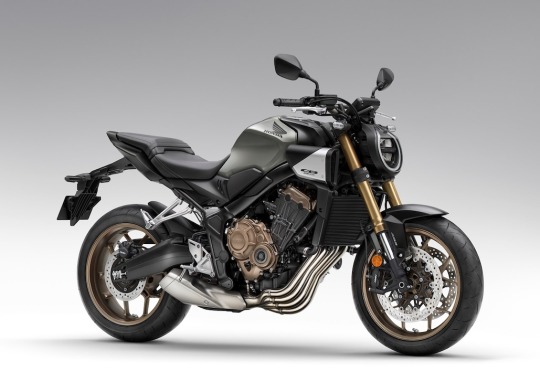

For 24YM Honda’s naked four-cylinder jewel evolves its Neo Sports Café style with a sharp styling update from nose to tail. A brand-new 5-inch TFT screen offers Honda RoadSync connectivity, operated by simplified new 4-way toggle switch. Engine performance is unchanged at 70kW power and 63Nm torque, with an A2 option. The CB650R - alongside the CBR650R super sports bike - will be the first Honda to be offered with the option of Honda E-Clutch technology, which gives the rider choice of automatic clutch operation by simply using the shift pedal. Chassis specification includes Showa SFF-BP USD forks, dual four-piston radial mount front calipers and 120/70-ZR17 and 180/55-ZR17 tyre combination. Two brand-new paint options and two new colour combinations strike a contemporary chord.
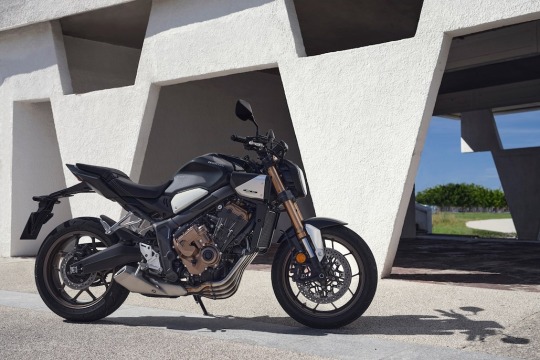
- Introduction Honda has always thrived on exploring new boundaries – in design as well as engineering. In 18YM, the CB1000R, CB300R and CB125R brought a fresh identity to its naked motorcycle line-up, mixing café racer inspirations with a forward-looking ultra-minimalist look under the ‘Neo Sports Café’ design theme. In 19YM the CB650R joined the family and its combination of cool styling, exhilarating four-cylinder engine performance and light, versatile handling ensured immediate sales success. Building on the momentum, for 21YM it received a major front suspension upgrade, plus a range of detail improvements to enhance comfort, usability and practicality. 24YM is an important year for the CB650R and while updated style and functionality will get attention, this bike – alongside its naked sibling, the CBR650R – will go down in history as the first Honda to be available with Honda E-Clutch technology, which is designed to make motorcycling, from beginner right through to expert, even more enjoyable – and even more exciting. Valerio Aiello, of Honda’s Rome R&D Department on the Neo Sports Café design aesthetic: “The entire current Neo Sport Café range from Honda is the result of the CB4 Concept model presented at EICMA in 2015. Our desire was to explore the world of the café racer and reinterpret it in a modern key. We wanted to create neo-classics – that is, modern motorcycles showcasing classic design styles combined with modern techniques. I used inspiration from outside the world of motorcycles, in watches. I’ve always liked their technicality and one of the key concepts used during the Neo Sports Café design was 'Mechanical Art'. This is the desire to show the beauty of the various mechanical elements to which Honda has always given great importance.”
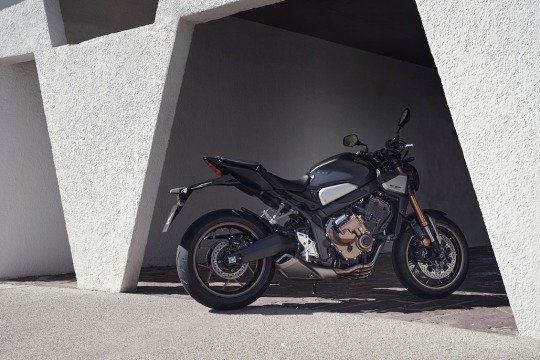
- Model Overview There’s a fresh look to the CB650R’s retro minimalism. A new headlight, radiator shrouds, rider/pillion seat, tail unit and taillight inject a more dynamic energy, while the fuel tank remains a strong presence above the beautiful inline four-cylinder engine. A new 5-inch full colour TFT screen is designed for readability on bright days and features Honda RoadSync connectivity. Managed by a new, easy-to-use 4-way lefthand backlit toggle switch the rider can now enjoy on-screen, turn-by-turn navigation in addition to other smartphone features. Performance is unchanged: 70kw peak power with 63Nm are fun figures for a naked bike, and the classic in-line 4 cylinder ‘pick-up’ and high-revving top end power are longstanding Honda calling cards. A 35kW option is available for A2 licence holders. Available as an option on the CB650R, the new Honda E-Clutch takes away the need for the rider to use the clutch lever to make a shift either up or down the gearbox. The chassis is as before and a perfect package from city block to twisting back road. A steel diamond frame provides core rigidity while 41mm Showa SFF-BP USD front forks and Showa rear shock deliver high-quality suspension control. Four-piston radial-mount front brake calipers work 310mm floating discs and cast aluminium wheels mount 120/70-ZR17 and 180/55-ZR17 front and rear tyres. The 24YM CB650R will be available in the following colour options: **NEW** Matt Laurel Green Metallic with Matt Vulcan Silver Metallic details **NEW** Pearl Smokey Gray, with Matt Crypton Silver Metallic details Candy Chromosphere Red with NEW Matt Crypton Silver Metallic details Matt Gunpowder Black Metallic with NEW Matt Crypton Silver Metallic details
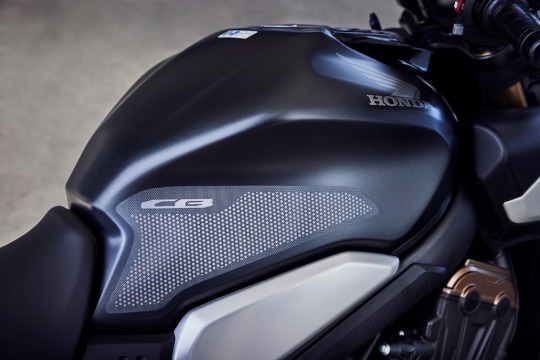
- Key Features 3.1 Styling & Equipment - Neo Sports Café styling evolves dynamically - New 5-inch full colour TFT screen includes Honda RoadSync connectivity for on-screen turn-by-turn navigation and access to other smartphone functions - New, simplified left hand switchgear easy to use and backlit for night-time - All lighting LED; new slanted headlight matched by new taillight design Tightly wrapped, the CB650R’s Neo Sports Café style evolution features the signature compact ‘Trapezoid’ proportion of a new, sharper tail and short-overhang and new slanted LED headlight All other lighting is LED, and a new taillight tucks seamlessly into the new fairing. From the front, via the new radiator shrouds backwards, the overall look is sinuous, more dynamic and with keen sense of purpose. The long fuel tank remains a key motif of the family design; its smooth lines accentuate the solidity of real metal surfaces and crown the engineering of the four-cylinder powerplant. It also houses the ignition. A 35° handlebar angle makes tight, slow-speed turns and U-turns straightforward. The shape of the pillion and rider seats have been revised to match the new tail; seat height remains 810mm. There’s a USB Type-C socket located under the seat. Premium technology – in the form of a brand new, 5-inch full colour TFT screen – uses optical bonding to improve visibility in bright sunlight. By sealing the gap between the cover glass and TFT screen with resin, glare is reduced, and visibility improved. The display itself is customisable between ‘Bar’, ‘Circle’ and ‘Simple’ display patterns and also, for the first time on the CB650R, offers the smartphone connectivity of Honda RoadSync. Honda RoadSync – alongside a new simplified, easy-to-use, backlit 4-way toggle-switch on the left handlebar – allows straightforward, on-screen turn-by-turn navigation as well as the option (via a Bluetooth helmet headset) for the rider to make calls, listen to music or receive voice feedback of weather conditions. All an owner has to do is download the free Honda RoadSync app from either the Play Store or the App Store, connect to the CB650R, and go.
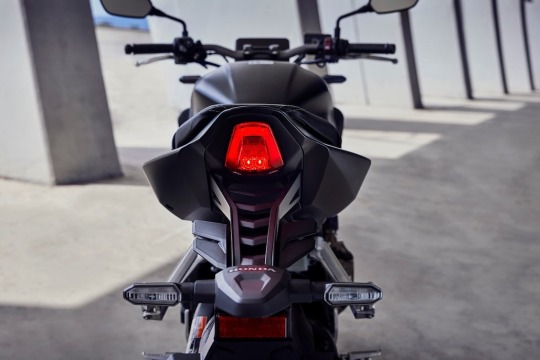
3.2 Chassis - 41mm Showa Separate Function Big Piston (SFF-BP) USD forks - Four-piston, radial-mount front brake calipers and floating discs - 120/70-ZR17 and 180/55-ZR17 front and rear tyres The steel diamond frame uses pressed swingarm pivot plates and twin elliptical spars with a rigidity balance specifically tuned (stiffer around the headstock and more flexible in the spar sections) to deliver excellent all-round handling characteristics with high levels of rider feedback. Rake is set at 25.5° with trail of 100mm and wheelbase of 1,450mm. Kerb weight is 205kg (207kg E-Clutch). Showa’s 41mm Separate Function Big Piston (SFF-BP) USD forks offer high-quality reaction. A pressure separation damper in one fork tube and spring mechanism in the other deliver high damping performance and lighter weight. Together with the use of a larger sized piston, the result is increased feel, bump absorption and control. Adjustable for 10-stage spring preload, the single-tube monoshock operates directly on the curvaceous gravity die-cast aluminium swingarm. Four-piston radial-mount front brake calipers work 310mm floating discs, and are paired with a single-piston rear caliper and 240mm disc. The ABS is a two-channel system. Cast aluminium wheels mount 120/70-ZR17 and 180/55-ZR17 front and rear tyres.

3.3 Engine - 70kW peak power with 63Nm peak torque - 35kW A2 licence option available - Honda Selectable Torque Control (HSTC) The 649cc, DOHC 16-valve engine is unchanged for 24YM. It’s tuned to create the purest, most enjoyable mid-sized four-cylinder performance possible, with the classically fast ‘pick-up’ through the rev range and hard-hitting, high-revving top end for which Honda’s in-line fours are renowned. Peak power of 70kW arrives @ 12,000rpm with peak torque @ 63Nm delivered at 9,500 rpm. A 35kW option is available for A2 licence holders. Direct cam actuation makes for a compact cylinder head; bore and stroke is set at 67mm x 46mm with compression ratio raised of 11.6:1. Iridium spark plugs are employed and twin air ducts – either side of the fuel tank – feed the airbox and produce a throaty intake roar. Asymmetric piston skirts minimise bore contact and reduce friction. Ferrous spines on the outer surface of the cylinder sleeves reduce oil consumption (and friction) with improved heat transfer and a silent SV cam chain reduces frictional losses by using a Vanadium coating on its pins. Internal water channelling from cylinder head to cylinders does away with most of the exterior hoses. The engine uses a compact internal architecture, stacked six-speed gearbox and starter layout with the cylinders canted forward 30°. An assist/slipper clutch eases upshifts while managing rear-wheel lock up under hard braking and rapid downshifts. Honda Selectable Torque Control (HSTC) manages rear wheel traction; it can be turned off should the rider choose. Fuel consumption of 20.4km/l (WMTC mode) gives a range of over 300km from the 15.4L fuel tank. EURO5 compliant, environmental efficiency has been updated with revisions to the ECU and catalyser, as well as the addition of an OBD2-2 sensor.
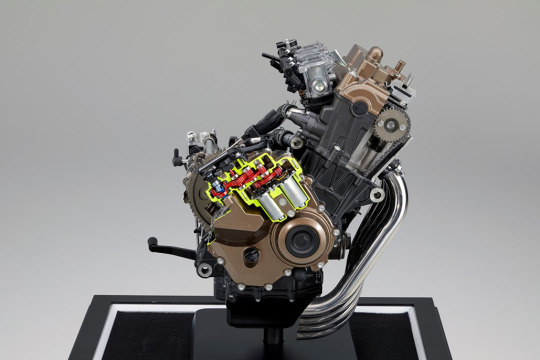
- Honda E-Clutch - see separate post - World-first technology allows the rider to start, stop and change gear without using the clutch lever – just the shift pedal - Available as an option from new; system adds 2kg to kerb weight - Honda E-Clutch also allows normal operation of the clutch lever - Brings more enjoyment and flexibility across a wide range of scenarios, for a ‘next level’ riding experience Honda E-Clutch takes elements of the technology and performance of quickshifters, manually-operated clutches and Honda’s Dual Clutch Transmission technology to create a unique blend of these well-proven approaches, opening up a whole new aspect of the motorcycling experience for riders of every type and experience level. The clutch and transmission hardware themselves are no different from a conventional motorcycle, with the ultra-compact system weighing only 2 kilograms. In operation, Honda E-clutch is simplicity itself, taking away the need to use the clutch lever to make a shift either up or down the gearbox. The rider simply has to operate the shift pedal for ultra-fast, consistent gear changes, bringing extra enjoyment to sporty riding. The clutch lever is also not needed when pulling away or coming to a stop. Becoming active as soon as the engine is switched on, the system manages both scenarios smoothly, while taking away the possibility of the engine stalling when in operation, providing extra convenience and peace of mind to town riding involving frequent starts and stops.

In addition to enjoyment and convenience, Honda E-Clutch brings ultimate flexibility. Should the rider wish, they are able to operate the clutch lever as normal at any time. When the clutch lever is used, the Honda E-clutch system will re-activate after less than a second above a certain engine rpm; after 5 seconds at lower engine speeds. Should the rider wish to turn off the system for a particular ride, this is also possible via the switchgear on the left handlebar. The change to manual operation is indicated by a letter ‘M’ on the instrument panel. The Honda E-Clutch also allows the rider to select an ‘operation feel’ to set the strength of the force required on the shift pedal to make a gear change. Three settings are available: HARD, MEDIUM, and SOFT, each of which can be chosen independently for upshifting and downshifting. The technology will also advise the rider to shift down - via a symbol on the instrument panel - if it detects the motorcycle is in a high gear at a certain speed. The Honda E-Clutch manages clutch engagement and disengagement based on its reading of parameters including vehicle speed, throttle opening angle, engine rpm, pressure on the shift pedal, clutch motor reduction gear angle, engine countershaft speed and gear position. The clutch is operated through an actuator unit with two motors situated inside the right hand engine cover. As the clutch is engaged or disengaged, the engine’s ignition timing and fuel injection are also controlled, resulting in smooth, shock-free shifting in any situation. Junya Ono, Large Project Leader, Honda E-Clutch: “Our Honda E-Clutch is designed to offer motorcyclists a new kind of experience that can make their riding even more fun and exciting. It also adds peace of mind and comfort to town riding or the daily commute. We hope that many riders will try our new system to enjoy the unique mix of sportiness and flexibility it offers.”
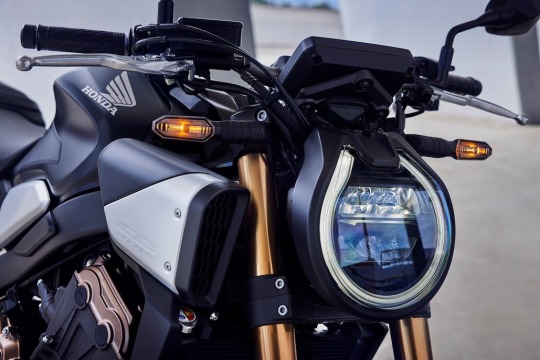
- Accessories A range of Genuine Honda Accessories are available for the CB650R, both available as individual items and grouped in packs, and are ready to bolt straight on: Style Pack Designed to complement the looks and style of the CB650R by adding high-quality aluminium inserts, Front Fender Panels, Radiator Shroud Covers, Side Cover Panels and Tank Side Stickers for added grip and protection. A red adonised Oil Level Gauge featuring the Honda logo adds a touch of colour and contrast. Sport Pack Pumps up dynamism with a Quickshifter (for non E-Clutch model), instrument Flyscreen for added wind protection, a Pillion Seat Cover featuring a dedicated aluminium plate, an Under Cowl that enhances the sporty appearance and finally, a Tank Pad that adds practical protection. Comfort Pack Cold weather rideability is improved with the addition of 5 stage Heated Grips with a memory function, plus the flexible, easy-to-attach carrying capacity of a Tank Bag with a see-through pocket for smartphones and an expandable 17L Rear Seat Bag that can be increased to 22L. The line-up is completed with Wheel Stripes available in different colours. All the accessories featured in packs can also be purchased individually. - Technical Specifications ENGINE Type Liquid-cooled 4-stroke 16-valve DOHC inline-4 cylinder Engine Displacement (cm³) 649cc Bore ´ Stroke (mm) 67.0 x 46.0 Compression Ratio 11.6:1 Max. Power Output 70kW/12,000rpm Max. Torque 63Nm/9,500rpm Oil Capacity 2.7L Noise Level (dB) Lwot – 78.8, Lurban – 74.2 FUEL SYSTEM Carburation PGM-FI electronic fuel injection Fuel Tank Capacity 15.4L Fuel Consumption 20.4km/litre ELECTRICAL SYSTEM Starter Electric Battery Capacity 12V/8.6AH ACG Output 380W DRIVETRAIN Clutch Type Wet, multiplate disc Transmission Type 6-speed Final Drive Chain FRAME Type Steel diamond CHASSIS Dimensions (LxWxH) 2130 x 780 x 1075mm Wheelbase 1450mm Caster Angle 25.5° Trail 100mm Seat Height 810mm Ground Clearance 150mm Kerb Weight 205kg 207kg E-Clutch Turning radius 2.8m SUSPENSION Type Front 41mm Showa Separate Function front Fork Big Piston (SFF-BP) USD forks Type Rear Monoshock damper with 10 stage adjustable preload, 43.5mm stroke WHEELS Rim Size Front Hollow section 6-spoke cast aluminium Rim Size Rear Hollow section 6-spoke cast aluminium Tyres Front 120/70ZR17 M/C (58W) Tyres Rear 180/55ZR17 M/C (73W) BRAKES ABS System Type 2 channel; hydraulic dual disc 310mm front, hydraulic disc 240mm rear INSTRUMENTS & ELECTRICS Instruments Digital speedometer, digital bar graph tachometer, dual trip meter, digital bar graph fuel gauge, gear position and upshift indicator, digital clock Headlight LED Taillight LED # Please note that the figures provided are results obtained by Honda under standardised testing conditions prescribed by WMTC. Tests are conducted on a rolling road using a standard version of the vehicle with only one rider and no additional optional equipment. Actual fuel consumption may vary depending on how you ride, how you maintain your vehicle, weather, road conditions, tire pressure, installation of accessories, cargo, rider and passenger weight, and other factors. Read the full article
6 notes
·
View notes
Text
BMW GINA: A Revolutionary Design Concept
BMW GINA

Table of Contents
Introduction: Unveiling the BMW GINA
The Groundbreaking Design of the BMW GINA
GINA's Adaptive Fabric Exterior: A Game Changer
Innovative Features of the BMW GINA
Performance and Technology: Driving the Future
Frequently Asked Questions (FAQs)
Conclusion
"BMW GINA 2023" is an upcoming model by BMW, featuring a groundbreaking design concept that incorporates a flexible fabric body and innovative technologies.
Introduction: Unveiling the BMW GINA
When it comes to pushing the boundaries of automotive design, BMW has always been at the forefront. One notable example of their visionary approach is the BMW GINA, a concept car that took the industry by storm with its revolutionary design and forward-thinking features. In this article, we delve into the captivating world of the BMW GINA, exploring its groundbreaking design, innovative features, and its impact on the future of automotive engineering.
The Groundbreaking Design of the BMW GINA
The BMW GINA stunned the world with its unconventional and futuristic design philosophy. GINA, which stands for "Geometry and Functions in 'N' Adaptations," was unveiled in 2008 and challenged the traditional notion of a car's body structure. Instead of relying on rigid metal panels, the GINA featured a flexible fabric skin that could adapt and change its shape according to different driving conditions and user preferences.

GINA's Adaptive Fabric Exterior: A Game Changer
At the heart of the BMW GINA's design lies its adaptive fabric exterior, which is made from a specialized high-tech fabric called Spandex. This innovative material, combined with a network of hidden metal wires and components, allows the car's exterior to morph and transform, giving it an unparalleled level of versatility. The fabric skin stretches and contracts, creating a seamless surface that smoothly adapts to various driving situations, enhancing aerodynamics and improving overall performance.
Innovative Features of the BMW GINA
The BMW GINA showcases a range of cutting-edge features that set it apart from conventional vehicles. One of the standout elements is the movable subframe, which can adjust the shape and position of the car's headlights and grille. This dynamic feature not only enhances aerodynamic efficiency but also allows for a personalized and expressive front-end design.
Additionally, the GINA's doors are a marvel of engineering. Instead of traditional hinged doors, the GINA features articulated metal and fabric wings that elegantly open and close, providing both functionality and aesthetic appeal. This unique design element not only facilitates ease of entry and exit but also adds a touch of theatricality to the overall driving experience.

Performance and Technology: Driving the Future
While the BMW GINA's design is undeniably its standout feature, it is complemented by advanced performance and technology. The concept car is equipped with a powerful engine, delivering exhilarating acceleration and impressive speed. Furthermore, the interior of the GINA boasts a minimalist and driver-centric design, incorporating state-of-the-art technology and intuitive controls that enhance the overall driving experience.
Frequently Asked Questions (FAQs)
Q1: How does the adaptive fabric exterior of the BMW GINA work?
The adaptive fabric exterior of the BMW GINA is made from a flexible fabric material called Spandex, combined with a network of metal wires and components. This allows the car's exterior to change shape and adapt to different driving conditions and user preferences.
Q2: Can the BMW GINA's fabric skin withstand harsh weather conditions?
Yes, the fabric skin of the BMW GINA is designed to be weather-resistant and durable. It can withstand a variety of weather conditions while maintaining its flexibility and adaptive properties.
Q3: Is the BMW GINA a production car?
No, the BMW GINA is a concept car that showcases innovative design and technology. It was never intended for mass production but rather served as a platform to explore new ideas and push the boundaries of automotive design.
Q4: Are there any plans to incorporate the GINA's design features in future BMW models?
While the exact design features of the BMW GINA may not be directly integrated into future BMW models, the concept car has undoubtedly influenced the brand's design philosophy. The GINA's spirit of innovation and pushing boundaries can be seen in BMW's ongoing pursuit of revolutionary design and cutting-edge technology.
Q5: How does the BMW GINA contribute to the future of automotive engineering?
The BMW GINA represents a leap forward in automotive engineering by challenging traditional design concepts. Its adaptive fabric exterior and innovative features serve as a catalyst for exploring new possibilities and reimagining the future of transportation.
Conclusion
The BMW GINA stands as a testament to BMW's unwavering commitment to pushing the boundaries of automotive design and engineering. Its groundbreaking concept, featuring an adaptive fabric exterior and innovative features, has captivated automotive enthusiasts and industry experts alike. While the GINA may not have directly influenced mass-produced vehicles, its impact on the future of automotive engineering is undeniable. As BMW continues to embrace innovation and reimagine the possibilities of mobility, the spirit of the BMW GINA will undoubtedly live on in the brand's future endeavors.
#car 2023#2023 bmw#bmw i7 2023#challenge 2023#most expensive car 2023#bmw z4 concept touring 2023#bmw concept touring coupe 2023#bmw concept touring coupe 2023 innenraum#concept cars 2021#2013 srt viper#bmw gina light visionary model revealed 2024#concept car#concept cars#bmw concept car#bmw#new bmw#bmw concept#bmw gina#gina#gina concept#avtr#mercedes avtr#coolest cars in the world#coolest concept cars#supercar blondie#sergi galiano
5 notes
·
View notes
Text
Enlightening the Future: The Wonders of LED Lighting
In this blog post, we will delve into the captivating realm of LED lighting, examining its many advantages, diverse applications, and its pivotal role in forging a more sustainable and energy- conscious future.
The Evolution of Illumination
Before we explore the myriad advantages of LED lighting, it's important to appreciate the historical context. For many decades, incandescent bulbs dominated the lighting landscape, casting warm but highly inefficient light. These bulbs were notorious for generating excessive heat and consuming copious amounts of energy.
In the mid-20th century, fluorescent lighting emerged as a more energy-efficient alternative, but it had its share of drawbacks, including the presence of hazardous materials like mercury. However, the 21st century ushered in the era of LEDs, which addressed these issues and introduced a host of transformative benefits.
Advantages of LED Lighting
Energy Efficiency: LEDs are astoundingly energy-efficient, using up to 80% less energy than traditional incandescent bulbs. As a result, you save a lot on your electricity bill.
Longevity: LED bulbs boast an impressive lifespan, often exceeding 25,000 hours or more. This results in less waste and fewer replacements.
Durability: LEDs are solid-state lighting devices, making them more robust and resilient to shocks and vibrations compared to fragile incandescent and fluorescent bulbs.
Instant Illumination: LEDs provide instant brightness without the warm-up time associated with some other lighting technologies.
Color Variety: LEDs are available in a wide range of colors and color temperatures, facilitating creative and customized lighting solutions.
Environmental Friendliness: LEDs are environmentally responsible, emitting less heat and containing no hazardous materials. Their lower energy consumption also contributes to reduced greenhouse gas emissions.
Applications of LED Lighting
The versatility of LED lighting is reflected in its extensive range of applications, reshaping diverse industries and enhancing our everyday experiences. Here are some noteworthy uses:
Home Lighting: LED bulbs are widely used for general lighting, accent lighting, and even integrated into smart lighting systems that can be controlled remotely for convenience.
Commercial and Industrial Lighting: LEDs have become indispensable in warehouses, offices, factories, and retail spaces due to their energy efficiency and long life.
Street Lighting: Many municipalities have adopted LED streetlights to save energy and improve nighttime visibility.
Automotive Lighting: LED headlights, taillights, and interior lighting have become the standard in modern vehicles for their brightness and energy efficiency.
Entertainment and Decorative Lighting: LEDs are the go-to choice for creating captivating and dynamic lighting displays at concerts, events, and theme parks.
Healthcare and Horticulture: LEDs play a pivotal role in healthcare for surgical lighting and horticulture for controlled plant growth.
The Future of LED Lighting
The future of LED lighting holds immense promise. With advancing technology, we can anticipate even more energy-efficient, intelligent, and sustainable lighting solutions.
Smart Lighting Integration: Seamless integration with smart home systems will offer personalized lighting experiences, enhancing comfort and energy savings.
Human-Centric Lighting: LEDs will increasingly mimic natural daylight, supporting circadian rhythms and promoting overall well-being.
Li-Fi Technology: LEDs may play a significant role in Li-Fi, a technology that uses light waves for high-speed wireless communication.
Sustainable Design: LEDs will be prominently featured in sustainable architectural and interior designs, further reducing energy consumption and environmental impact.
Conclusion
LED lighting has not only illuminated our surroundings but has also brightened the path to a more energy-efficient and sustainable future. From the coziness of our homes to the brilliance of city streets, LEDs have transformed the way we see the world. As technology continues to evolve, we can eagerly anticipate innovative advancements and applications in the realm of LED lighting, all contributing to a greener and more comfortable planet for generations to come. So, embrace the brilliance of LEDs and be a part of the enlightened future of illumination!
Abhay V Shah.
CEO
Hozon Tech Innovation Private Limited
Mumbai
#LEDLighting#EnergyEfficiency#SustainableTech#GreenTech#LightingSolutions#SmartLighting#EnergySavings#EcoFriendly#GreenLiving#FutureOfLighting#LightingDesign#LEDAdvancements#CleanEnergy#EnvironmentallyFriendly#LightingTechnology#BrightIdeas#EfficientLighting#Sustainability#GreenInnovation#LEDBenefits
4 notes
·
View notes
Text

2025 Mini Cooper Countryman S ALL4 Review
The 2025 MINI Cooper Countryman is the largest, most versatile MINI yet, blending iconic style with increased practicality. Its expanded dimensions offer more interior space, while the refined design, including bold LED headlights and sleek alloy wheels, enhances its road presence.
Interior Features
The interior of the 2025 MINI Cooper S ALL4 Countryman blends sophisticated craftsmanship with modern technology, creating a driving experience that appeals to both your comfort and style. High-quality materials, cutting-edge features, and customizable ambient lighting elevate the cabin's atmosphere. The redesigned toggle controls put essential functions, like the parking brake, gear selection, and MINI Experience Modes, at your fingertips for effortless control.
The new MINI Cooper Countryman has a slightly smaller steering wheel, enhancing the iconic go-kart feeling. The recycled, high-quality textiles used throughout the cabin offer a luxurious feel and serve as a backdrop for the dynamic MINI Experience Modes. The rear seats are designed flexibly, offering a 40/20/40 split to accommodate passengers and cargo. With a longer and taller frame, the new Countryman offers up to 25% more cargo space, ensuring practicality without compromising its signature style.
Exterior Features
Introducing the most refined and spacious MINI yet—the 2025 MINI Cooper S ALL4 Countryman. Now extended by 13 cm and standing 6 cm taller, this model boasts a larger, more commanding presence to handle all your adventures. An octagonal front grille, dynamic LED headlights, and a distinctive Powerdome hood highlight its bold exterior design. The sleek silhouette is enhanced by short overhangs and finely detailed contours, giving it a refined yet rugged appeal. Bold, aerodynamic, light-alloy wheels, available in sizes ranging from 18 to 20 inches, are eye-catching and crafted from recycled aluminum for high performance and sustainability.
The standard high-gloss black roof rails and redesigned C-pillar add a touch of sophistication. In contrast, the contrasting roof, available in various striking colours, adds to the vehicle's distinctive character. As you approach, an impressive welcome display illuminates, complete with optional front and rear light signatures and a logo projection by the front doors, setting the tone for every journey.
Performance
The 2025 MINI Cooper S ALL4 Countryman takes performance to new heights, delivering more power and excitement than ever. Standard ALL4 All-Wheel Drive is built to handle the terrain, offering rugged versatility and MINI's signature go-kart-like handling. The TwinPower Turbo engine provides a thrilling blend of punchy acceleration and remarkable fuel efficiency, ensuring that every drive is dynamic and economical.
Standard on the Cooper S Countryman with the Premier+ Package is MINI's advanced Driving Assistant Professional, allowing semi-autonomous driving at speeds up to 60 km/h—perfect for easing through stop-and-go traffic. Whether navigating challenging weather or uneven roads, the ALL4 system dynamically distributes power to all wheels, giving you confidence and control in any conditions. For added safety, the standard Driving Assistant helps keep you alert with features like blind spot detection, active lane correction, and rear traffic alerts to prevent mishaps when reversing.
CONTACT US
Have questions about the 2025 MINI Cooper Countryman? Contact Overseas Motors MINI, your trusted MINI Cooper dealership near me. Whether you're looking for a 2025 MINI Cooper Countryman review, details on the Mini Cooper Countryman price, or searching for a Mini Cooper Countryman for sale, our team is here to help. Visit us today and explore the 2025 MINI Countryman lineup in person!
1 note
·
View note
Text
Adaptive and Intelligent Lighting Systems
Automotive lighting has undergone evolution not solely concerning the light source, but also in terms of how the light is dispersed and utilized. Considering that technology is advancing daily, modern automobiles are fitted with very elaborate adaptive and intelligent lighting systems by Headlight Manufacturer.
These systems soar into the sky higher than their basic objectives-and provide the driver with good visibility and safety, hence resulting in a smoother driving experience. The interior ambiance is also illuminated by the Adaptive Front Lighting System.
Adaptive Front-Lighting System (AFS)
Concept: Depending on the vehicle's load, speed, and the steering angle, the AFS is designed to adjust the direction and range of the beams of the headlights. Especially in winding or varying terrain, this enables optimal illumination of the road ahead.
Working of AFS System
Functionality: Sensors detect the vehicle speed, steering angle, and yaw rate when a vehicle makes a turn. To better illuminate the road’s curve, the AFS then adjusts the headlamp’s projection angle provided by Four-Wheeler Headlight Supplier. Especially during nighttime driving on winding roads, this is useful.
Benefits: AFS decreases the risk of blinding oncoming drivers and expands the driver’s visibility around bends by dynamically adjusting the beam direction which ultimately contributes to a safer driving experience.

Automatic High Beam Control
Purpose: Based on the surrounding lighting conditions and traffic, this system automates the switching between high and low beams.
How It Works: The system detects vehicles from behind, oncoming vehicles, or sufficient ambient light using cameras and sensors. To prevent dazzling other road users, it will automatically shift to a low beam upon detection and revert to a high beam when the coast is clear.
Safety Implications: This system expands the visibility for drivers without compromising the safety of other road users by ensuring the optimal use of high beams.
Design Philosophy: In interior lighting, the main purpose is neither always aesthetics nor functionality but the creation of an intended ambience.
Features: Usually, colored LED lights are used, and their colors and intensities can be changed according to the driver's mood. Areas covered by Ambient Lighting for Four wheeler include footwells, cup holders, door handles, and center consoles.
User Experience: A driver can set a mood for the ambiance in the cabin. In fact for some vehicles, pre-set modes such as 'relax' or 'energetic' exist, which will automatically change the color and intensity of the lighting to correspond with the chosen mode. The role of adaptive and intelligent lighting systems becomes ever more critical as vehicles continue to incorporate more advanced technologies. While these systems primarily aim to enhance the driving experience, their fundamental purpose lies in ensuring safety by providing optimal visibility for the driver while reducing disruptions for other road users. The future of automotive lighting and global automotive lighting Exporter is epitomized by the seamless integration of functionality, safety, and aesthetics within these systems.
#automotive lamp manufacturer#hub motor manufacturer#indian automotive lighting suppliers#oem automotive lighting#reflex reflector manufacturer#multi focal reflector manufacturer#led automotive lighting manufacturer#automotive exterior lighting manufacturer#automotive lighting#fog lamp manufacturer#automation#automative parts
0 notes
Text
MG4 EV vs. BYD Atto 3: A New Era of Compact Electric Cars in the Gulf
As the Gulf markets and the world accelerate their shift toward electric vehicles (EVs), new contenders are emerging in the compact EV segment, led by the MG4 EV and BYD Atto 3. Both models represent a new generation of Chinese electric cars that combine modern design, smart technologies, and practical performance — all while maintaining competitive pricing that appeals to a broad audience.
This comparison highlights the key strengths and differences between the MG4 EV and BYD Atto 3 to help drivers select the model that best suits their lifestyle.
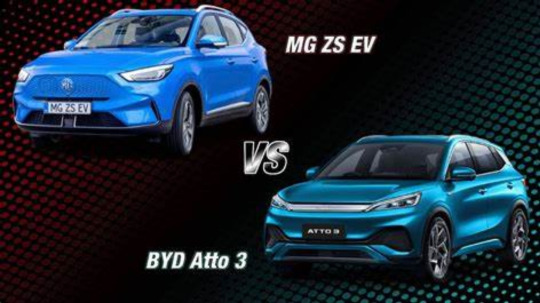
Exterior and Interior Design
🚗 MG4 EV
Bold, dynamic design with sharp lines
Eye-catching LED headlights and taillights
Long wheelbase, enhancing interior spaciousness
Cabin: clean and practical layout with large central touchscreen, digital instrument cluster, and good material quality for its price
🚙 BYD Atto 3
Streamlined, youthful design with a sporty front end
Curved side profile reflecting a modern identity
Cabin: distinctive with a rotating central screen, sporty-inspired elements, smart storage, and comfortable seating
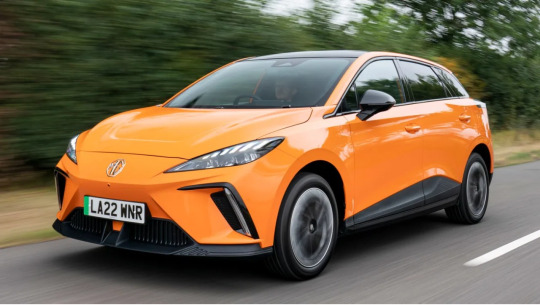
Performance and Electric Range
⚡ MG4 EV
Power: 170–204 hp (trim dependent)
Instant torque delivers brisk acceleration
Range: 350–450 km (varies by battery size)
Well-suited for daily commutes and city-to-city drives
⚡ BYD Atto 3
Power: 204 hp | Torque: 310 Nm
Advanced LFP battery technology
Range: 420–480 km per charge
Fast charging: up to 80% in <40 minutes — ideal for long trips
Technology and Safety Features
🖥 MG4 EV
Apple CarPlay & Android Auto support
Rearview camera
Adaptive cruise control
Automatic emergency braking
Lane-keeping assist
🖥 BYD Atto 3
Rotating infotainment screen (landscape or portrait mode)
Premium audio system
6 airbags
Blind-spot monitoring
Collision warning (front & rear)
Smart parking assistance
The content above comes from Cartea, the most professional automotive platform in the Middle East.
0 notes
Text

2026 VS 2025 RANGE ROVER VELAR: COMPARING THE LATEST LUXURY SUVS
RANGE ROVER VELAR OVERVIEW
● The Range Rover Velar exudes sophistication, perfectly reflecting your ethos. Aesthetic lines, clear contours, and futuristic finishes unite in a dramatic yet elegant style. Crafted with comfort and control in mind, the vehicle provides complete satisfaction for the well-traveled--everything is within reach, at your fingertips.
● The Inspired Collection, designed by expert engineers, the Velar is created to inspire the user's imagination--order and choose, or as a starting point to customize their own vision. Calm and modern, the vehicle has a harmonious Caraway interior that calms the senses, providing room for introspective thought, healing, and renewal.
● No doubt, the Range Rover Velar is an attractive vehicle but also delivers a tranquil haven especially provided to bestow sophistication with every drive. The car is particularly built for you and fulfills your dreams of ownership in every way.
● The next-gen Pivi Pro system provides infotainment, boasting a refined 11.4-inch touchscreen and adjustable controls within hand's reach--volume, climate, seats, you name it. The 3D surround camera system offers a 360-degree view of the environment around you, making it easy to navigate some of the most challenging terrains.
● A highly immersive sound experience greets you inside the Range Rover Velar. The powerful Meridian™ 3D Surround Sound System delivers high-quality audio to speakers fitted across the cabin. It creates a concert-like atmosphere in the cabin and lets you stay effortlessly connected on the road with the Online Package. Users also get access to embedded apps like Amazon Alexa and Spotify, while the SOTA, or Software-over-the-Air, keeps you up to date.
● Enjoy the convenience of wireless device charging and seamless connectivity, keeping your space clutter-free and your devices powered on the go. A suite of advanced driver assistance features enhances every journey, making driving and parking simpler, smarter, and safer.
● The Range Rover Velar is a confident vehicle that gives a composed drive, thanks to its sophisticated driving dynamics. The Adaptive Dynamics tracks body and steering movements up to 500 times per second, providing a smooth drive with optimal control. With Configurable Dynamics, you can set up a chassis and powertrain configuration that suits your driving style.
● Regardless of terrain, Intelligent All-Wheel Drive (AWD) with Intelligent Driveline Dynamics (IDD) manages torque distribution between front and rear axles to deliver maximum. Adjustable technologies also enhance your drive on the road, and the Dynamic mode within Terrain Response enhances performance, while the All-Terrain Progress Control sustains constant speed off-road for a comfortable driving experience. Adding more convenience, the Advanced Tow Assist removes the hassle of reversing with a trailer, making towing easy and hassle-free.
FREQUENTLY ASKED QUESTIONS
Q: What are some of the most significant differences between the 2026 and 2025 Range Rover Velar? A: The 2026 Range Rover Velar Canada brings significant upgrades to the 2025 version. One major shift is the addition of the new Autobiography trim in place of the HSE trim, which includes luxury touches such as a Meridian audio system, suede headliner, extended leather interior, and unique copper-colored exterior accents.
Q: Has the outside styling of the Range Rover Velar been altered from the 2025 to the 2026 model? A: Yes, the 2026 Range Rover Velar features a new exterior look, with the front grille having been redesigned, the headlights having been reduced in height but made thinner, and the stance made more aggressive, adding only to its aerodynamic and striking look.
Q: Are there any new interior features or technology advancements in the 2026 A: Range Rover Velar over the 2025 model? A: Yes, the 2026 Range Rover Velar in Canada features a number of interior upgrades to the 2025 model. Most importantly, it features the optional Meridian™ Signature Sound System with speakers and amplifier power, and brings in Cabin Air Purification Plus, which removes dust and microbes and also checks CO₂ levels to ensure occupant health.
Q: What engine options are available for the 2026 Range Rover Velar, and have they changed from 2025? A: The 2026 Range Rover Velar in Canada has the identical engine offerings as the 2025 model: P250: Turbocharged 2.0L inline-4 engine generating 247 hp and 269 lb-ft of torque. P400: 3.0L inline-6 mild hybrid engine with 395 hp and 406 lb-ft of torque. Each engine is matched with an 8-speed automatic transmission and standard all-wheel drive.
Contact Us
Walk into a trusted Range Rover dealership near me if you want to learn more about the Range Rover Velar price or if you are seeking a Range Rover Velar for sale Our Land Rover London showroom brings some of the best deals. Speak to our team members and they will guide you to the right vehicle just for you.
1 note
·
View note
Text
How do BMW's new laser headlights work and what advantage do they have over other headlight technologies?
BMW's laser headlights represent a groundbreaking leap in automotive lighting technology, combining advanced physics with intelligent safety systems. Here's a detailed breakdown of their working principles and key advantages over traditional lighting technologies:
1. Core Technology & Working Principle BMW's Laserlight system does not directly project laser beams onto the road but uses lasers to generate intense white light through a multi-stage process:
Laser Activation: Three blue laser diodes (wavelength ~450nm) emit high-intensity beams.
Mirror Reflection: The laser beams are directed through a series of mirrors within the headlamp assembly.
Phosphor Conversion: The blue lasers strike a lens filled with yellow phosphorus, triggering a chemical reaction that converts the light into bright white light (5,500–6,000K color temperature).
Diffusion & Projection: The white light is diffused to reduce glare and projected via a reflector bowl, achieving a focused beam.
This method produces 10x brighter light than LEDs while maintaining safety for human eyes and animals.
2. Key Advantages Over Traditional Technologies Feature Laserlight LED/Other Tech Brightness 600m max range (vs. 300m for LED) Limited by lower lumen density Energy Efficiency 30% less energy than LEDs Higher power consumption Beam Precision Laser-guided adaptive focus Fixed or less dynamic patterns Component Size Diodes 1/100th LED size (10μm) Bulky heat sinks required Lifespan 50,000–100,000 hours 30,000–50,000 hours (LED)
3. Intelligent Safety & Adaptive Features
Anti-Dazzle Control: Infrared cameras detect oncoming traffic and automatically dim/redirect beams.
Dynamic Light Spot: Focuses on obstacles (e.g., pedestrians, animals) up to 300ft (92m) ahead.
GPS-Enabled Steering: Syncs with navigation to pre-illuminate turns.
Speed-Activated Logic: Only activates at >60 km/h to avoid urban glare.
4. Design & Sustainability Benefits
Compact Housing: Smaller components allow sleeker headlight designs (e.g., BMW i8's slim profile).
Heat Management: Minimal heat output reduces cooling demands vs. LED/Xenon.
Material Innovation: Uses 0.7mm hardened glass layers for 50% weight reduction.
5. Limitations & Future Outlook
High Cost: Currently limited to premium models (e.g., X7, 8 Series).
Regulatory Hurdles: Required 7+ years for U.S. road approval.
Emerging Competitors: Audi's DML matrix lights challenge with pixel-level control.
BMW continues refining this technology, with plans to expand it to motorcycles and mid-tier vehicles by 2026. While not replacing LEDs entirely, laserlights redefine nighttime driving safety and efficiency for high-performance applications.

#led lights#car lights#led car light#youtube#led auto light#led headlights#led light#led headlight bulbs#ledlighting#young artist#car culture#cars#race cars#classic cars#car#suv#vehicle#automobile#muscle car#car light#yellow headlights#headlamp#headlight#car lamp#lamp#laser headlights#other headlight#bmw#bmw cars#vintage car
4 notes
·
View notes
Text

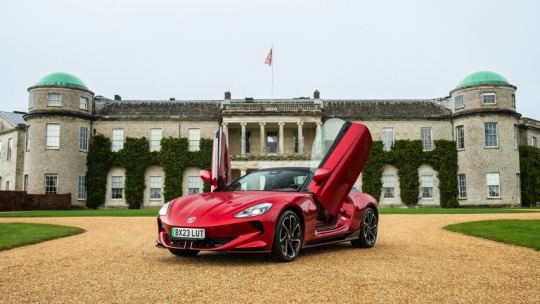
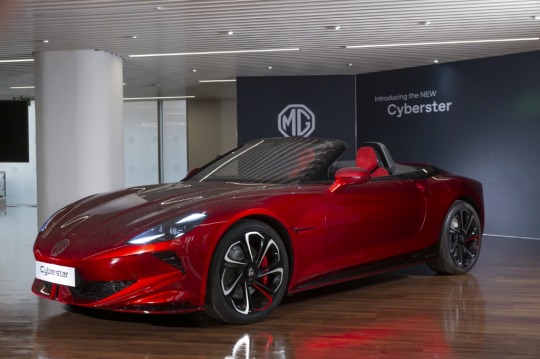
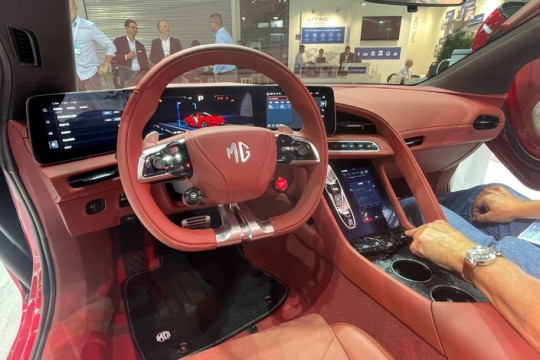
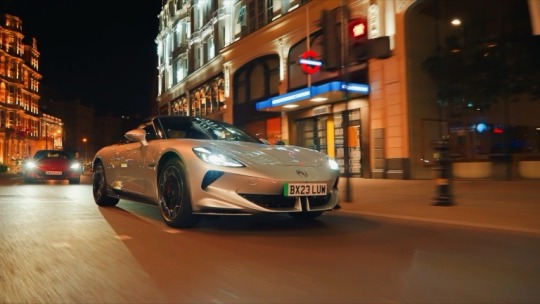
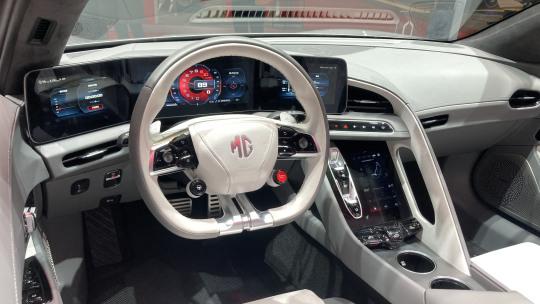
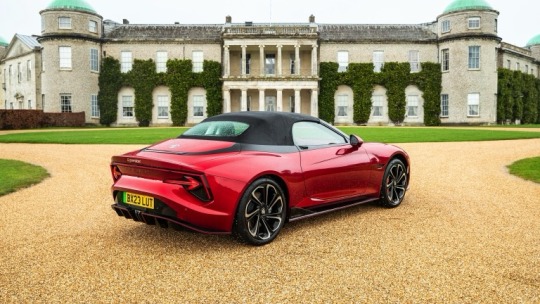
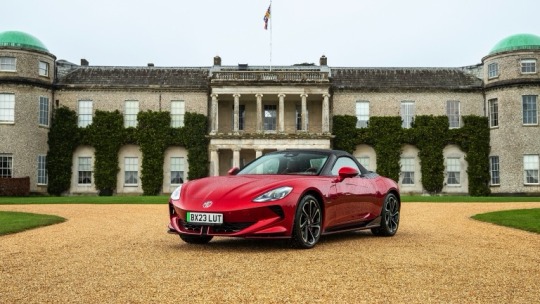
The new electric MG convertible might therefor be well placed to offer a more balanced option for those customers looking for a performance experience. Building upon the brand’s heritage and presence, this is anything other than a boring car. With formidable power and acceleration, plus a whole host of luxury and sporty finishes. As UK customers can discover on their configurator (https://www.mgcyberster.co.uk/configurator), there are two key options to choose from including:
Trophy - from £54,995 this is a Single Motor with 19” alloys; and
GT - from £59,995 this is a Dual Motor with 20” alloys.
Standard options include auto LED headlights, electrically adjustable / heated / folding door mirrors, front / rear parking sensors, electric scissor doors, fully electric good, launch control, 7” touch screen, wraparound 3-screen cockpit, 8-spekaer BOSE audio, adaptive cruise control, lane keep assist, active emergency braking, lane change assist, blind spot assist, heated seats, electric lumbar support, leather seats, wind deflector, climate control, keyless entry, ambient lighting, navigation, parking camera and V2L.
Colours include English White, Camden Grey, Cosmic Silver, Dynamic Red and Inca Yellow. Also choose between a standard black hood or, for the white / grey / silver option, consider the red hood. Inside, the interior options include Black / Red or Grey.
And how does the new Cyberster perform?
Trophy - this RWD Convertible will have a 74 kWh usable battery which will offer 0 – 62 times of 5.0 seconds, 121 mph top speeds and 250 kW (or 335hp). Expect a combined winter range of 225 miles with warmer weather allowing for 305 miles – a 265 mile combined. On charging, the 7.4 kW AC max will allow 12 hour and 30 min 0 – 100% charging times with the 144 kW DC maximum allowing 39 minute 10 – 80% times. A cargo volume of 249L is available with this car. It has a vehicle fuel equivalent of 144 mpg. It has Bidirectional capabilities, with the V2L (vehicle-to-load) supported; and
GT- this AWD Convertible will have a 74 kWh usable battery which will offer 0 – 62 times of 3.2 seconds, 124 mph top speeds and 375 kW (or 503hp). Expect a combined winter range of 210 miles with warmer weather allowing for 285 miles – a 250 mile combined. On charging, the 7.4 kW AC max will allow 12 hour and 30 min 0 – 100% charging times with the 144 kW DC maximum allowing 39 minute 10 – 80% times. A cargo volume of 249L is available with this car. It has a vehicle fuel equivalent of 136 mpg. It has Bidirectional capabilities, with the V2L (vehicle-to-load) supported.
2 notes
·
View notes
Text
Adaptive Lighting Systems Market Forecast and Strategic Insights 2032
The global Adaptive Lighting Systems Market is poised for significant growth, with its value estimated at USD 10,109.42 million in 2024 and projected to expand at a CAGR of 6.59% from 2025 to 2032. As industries and consumers increasingly demand smarter, more energy-efficient lighting, adaptive systems are quickly becoming the new standard across automotive, architectural, and residential spaces.
Adaptive lighting systems utilize sensors, controllers, and software algorithms to automatically adjust light output—modulating brightness, color temperature, and direction based on factors such as ambient light levels, human activity, or time of day. These systems not only optimize visibility and comfort but also significantly reduce energy consumption, making them highly attractive in today’s sustainability-driven world.
What Are Adaptive Lighting Systems?
Adaptive lighting systems refer to intelligent lighting solutions that react in real-time to environmental and user inputs. Depending on their application, these systems can:
Dim or brighten lighting based on ambient daylight.
Shift color temperature to match circadian rhythms.
Redirect beams in automotive headlights to follow curves or avoid glare.
Activate lighting in response to motion or presence in a room.
These functionalities are made possible through a combination of sensors (light, motion, occupancy), control units, and LED technology integrated into the lighting infrastructure.
Key Growth Drivers
1. Growing Demand for Smart Homes and Buildings
As more households and commercial spaces adopt smart technologies, adaptive lighting has emerged as a cornerstone of intelligent building systems. Integration with IoT platforms, voice assistants, and home automation systems boosts convenience and allows for energy savings through scheduled or responsive lighting.
2. Advancements in Automotive Lighting
Adaptive headlights have become a safety feature in many high-end and mid-range vehicles. These systems can adjust beam angles, brightness, and patterns in real-time to improve nighttime visibility and reduce glare for oncoming traffic. As regulations evolve and consumers prioritize road safety, automotive adaptive lighting is set to become more mainstream.
3. Energy Efficiency Regulations
Government mandates around the world are driving the adoption of energy-saving technologies. Adaptive lighting systems help meet stringent energy consumption targets without compromising user experience—especially in urban infrastructure, street lighting, and public buildings.
4. Commercial and Industrial Adoption
Office spaces, retail outlets, warehouses, and factories are increasingly embracing adaptive lighting to cut operational costs. Dynamic lighting enhances worker productivity, reduces fatigue, and ensures compliance with health and safety standards.
Market Segmentation
The Adaptive Lighting Systems Market can be categorized by:
Application: Automotive, Architectural, Residential, Commercial, Industrial, Street Lighting.
Component: Sensors, Controllers, Dimmers, Ballasts, Software.
Technology: LED, OLED, Fluorescent, Incandescent (LED dominating due to efficiency and versatility).
Installation: New Construction, Retrofit.
Among these, the automotive sector currently dominates due to the growing use of advanced driver-assistance systems (ADAS) and LED headlight innovations. However, the residential and commercial segments are quickly catching up with the rise in smart home penetration.
Regional Market Insights
North America and Europe lead the market in terms of adoption due to strong regulatory frameworks, energy efficiency initiatives, and technological maturity.
Asia-Pacific is expected to witness the fastest growth, driven by rapid urbanization, rising automotive production, and the development of smart city projects in countries like China, India, and Japan.
Middle East & Africa and Latin America offer emerging opportunities, especially in smart infrastructure and automotive sectors.
Key Market Players
The market is competitive and innovation-driven, with several key players offering integrated lighting solutions and continuously upgrading their product portfolios:
HELLA GmbH & Co. KGaA – A leader in automotive adaptive headlight technologies.
Koito Manufacturing Co., Ltd. – Known for cutting-edge vehicle lighting systems in both OEM and aftermarket spaces.
Valeo S.A. – Offers intelligent lighting and ADAS integration in the automotive domain.
Stanley Electric Co., Ltd. – Pioneers in headlamp innovations and advanced lighting components.
Marelli Automotive Lighting – Combines adaptive lighting with advanced sensor systems for enhanced vehicle safety.
ZKW Group GmbH – Specializes in premium adaptive lighting systems for luxury vehicle manufacturers.
Osram Continental GmbH – Joint venture offering smart automotive lighting modules and control units.
Robert Bosch GmbH – Known for its innovations across the automotive and smart building sectors, including adaptive lighting solutions.
These companies focus on R&D investment, strategic collaborations, and technology integration to stay competitive in the fast-evolving lighting landscape.
Opportunities and Challenges
Challenges:
High initial costs of installation, especially in retrofit applications.
Technical complexity and integration challenges in legacy systems.
Cybersecurity concerns with connected lighting systems in smart environments.
Opportunities:
Integration with AI and machine learning to create predictive and fully autonomous lighting systems.
5G connectivity enabling real-time remote control of street and public lighting systems.
Sustainable urban development and the push for carbon-neutral infrastructure offer a huge market for adaptive lighting.
Future Outlook
With smart technologies becoming integral to how we live and move, adaptive lighting systems are no longer a luxury—they are a necessity. From safer roadways and energy-efficient buildings to more responsive homes, the global market is set to grow at a healthy pace through 2032.
To explore detailed insights, forecasts, and strategic developments in this sector, view the Adaptive Lighting Systems Market Report by AnalystView Market Insights.
0 notes
Text
Automotive Lighting Market Future Trends Shaping Innovation, Technology, and Consumer Demand Globally
The automotive lighting market future trends are rapidly evolving, driven by advancements in technology, rising safety standards, and increasing consumer demand for sophisticated and efficient lighting systems. As the automotive industry shifts towards electrification, automation, and connectivity, lighting solutions are becoming more than just a necessity—they are integral to vehicle design, safety, and user experience.
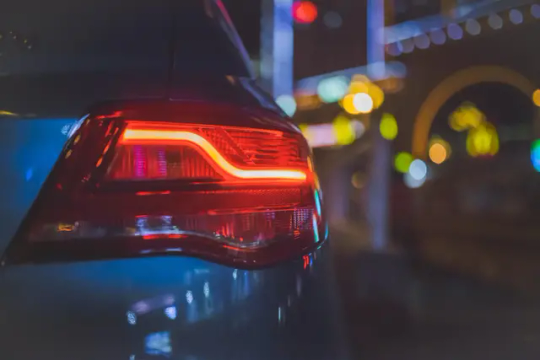
Technological Advancements in Automotive Lighting
One of the most significant drivers shaping the future of automotive lighting is the adoption of advanced lighting technologies. LED (Light Emitting Diode) lighting, which has already gained widespread acceptance due to its energy efficiency, longevity, and design flexibility, is now being supplemented and sometimes replaced by more sophisticated options such as OLED (Organic LED) and laser lighting.
OLEDs offer superior design freedom due to their thin, flexible form factors, enabling manufacturers to create innovative lighting signatures and enhanced interior ambiance. Laser lighting, although still in its early stages, promises ultra-high brightness and longer range, making it ideal for high-performance and autonomous vehicles.
Furthermore, smart lighting systems are on the rise. These systems incorporate sensors and communication technologies to adapt lighting patterns in real-time according to driving conditions, traffic, and environmental factors. Adaptive headlights that can automatically adjust their intensity and direction to avoid blinding other drivers while maximizing road illumination are becoming standard features in premium vehicles.
Integration with Autonomous and Connected Vehicles
As the automotive sector moves towards autonomous and connected vehicles, lighting is playing a crucial role in communication and safety. Exterior lights are increasingly used to signal intentions and communicate with pedestrians, cyclists, and other road users.
For instance, dynamic turn signals and pedestrian-friendly lighting that changes color or pattern to indicate vehicle behavior are emerging trends. Such features enhance road safety by reducing ambiguity and improving interaction between autonomous vehicles and their surroundings.
Connected lighting systems can also be integrated into vehicle-to-everything (V2X) communication networks, allowing cars to share information about road hazards or traffic conditions through light signals. This connectivity is expected to become a key trend, improving traffic flow and reducing accidents.
Sustainability and Energy Efficiency
Sustainability has become a focal point in the automotive industry, influencing the lighting market as well. The shift towards electric vehicles (EVs) emphasizes the need for energy-efficient components to maximize driving range. Automotive lighting manufacturers are responding by developing low-power, high-efficiency lighting systems.
Materials and manufacturing processes are also becoming greener, with companies adopting recyclable components and reducing hazardous substances. The trend towards sustainable lighting aligns with broader environmental goals and regulatory pressures.
Customization and Aesthetic Appeal
Consumer preferences are driving innovation in automotive lighting design. Modern car buyers expect personalized and stylish lighting elements that enhance the vehicle’s aesthetics and brand identity.
Dynamic lighting effects, customizable interior ambient lighting, and unique exterior signatures are increasingly used as selling points. Automotive brands are leveraging lighting to differentiate their vehicles, especially in luxury and electric segments, where design and technology interplay significantly.
Interior lighting customization, often controllable via smartphone apps or vehicle interfaces, allows drivers to create moods or themes, improving the overall driving experience. This trend is expanding into mid-range vehicle segments as technology becomes more affordable.
Market Challenges and Opportunities
Despite the promising future, the automotive lighting market faces challenges such as high development costs, complex regulatory requirements, and the need for standardization across regions. Ensuring reliability and durability in harsh automotive environments also demands rigorous testing and innovation.
However, these challenges open opportunities for collaboration between automakers, lighting manufacturers, and technology firms. Investments in research and development are expected to accelerate breakthroughs, particularly in smart lighting and communication-enabled systems.
Emerging markets present substantial growth potential as automotive ownership increases and safety regulations become more stringent. Manufacturers focusing on affordable, efficient lighting solutions tailored to these markets will likely gain competitive advantages.
Conclusion
The future of the automotive lighting market is shaped by dynamic trends in technology, sustainability, connectivity, and consumer expectations. Advancements such as OLED, laser lighting, and smart adaptive systems are redefining vehicle safety and aesthetics. Integration with autonomous vehicle technologies and V2X communication enhances road safety and traffic efficiency.
Sustainability and energy efficiency remain core drivers as the industry aligns with global environmental goals. Meanwhile, customization and design innovation continue to captivate consumers, adding value to automotive brands.
Navigating challenges like cost, regulation, and standardization will be critical for market players. Nonetheless, the evolving automotive lighting market promises exciting opportunities, making it a pivotal element in the future of mobility and automotive innovation.
0 notes
Text

2025 Toyota Prius Plug-In Hybrid Review
The 2025 Toyota Prius Plug-in Hybrid marks a significant evolution in Toyota's commitment to sustainable mobility. It combines advanced hybrid technology with enhanced electric capabilities. This latest iteration offers Canadian drivers an efficient, stylish, and technologically advanced vehicle tailored for modern driving needs.
Performance & Efficiency
Under the hood, the 2025 Prius Plug-In Hybrid is powered by Toyota's fifth-generation hybrid powertrain, which combines a 2.0L 4-cylinder DOHC 16-valve engine with advanced hybrid technology. This well-balanced engine system delivers both spirited performance and impressive fuel efficiency. The lithium-ion battery pack, now positioned under the rear seat, increases the electric-only driving range by more than 50% compared to the previous generation, offering up to 72 km on a single electric charge. Whether you're commuting to work or cruising along scenic routes, this new Prius Plug-In Hybrid strikes the perfect balance between electric power and combustion performance, ensuring an efficient yet dynamic driving experience. With an estimated fuel efficiency of around 4.3 L/100 km, the Prius Plug-In Hybrid is designed to go further on less, making it an ideal choice for eco-conscious drivers.
Design & Styling
The 2025 Prius Plug-In Hybrid showcases a bold, low, and wide stance, combining sleek aerodynamics with an eye-catching design. Its striking LED headlights and tail lamps not only provide improved visibility but also enhance the vehicle's overall airflow, contributing to its impressive fuel efficiency. The innovative battery placement under the rear seat lowers the vehicle's center of gravity, improving stability and driving dynamics. This thoughtful design also allows for maximized luggage space, ensuring that practicality matches its stylish aesthetics. The Prius Plug-In Hybrid is available in a selection of vibrant colors, including the sophisticated Wind Chill Pearl and the bold Supersonic Red, making it a true standout on the road. Whether you're navigating city streets or enjoying a weekend getaway, the Prius Plug-In Hybrid’s design is built to turn heads while ensuring functionality.
Technology & Safety
Inside the cabin, the 2025 Prius Plug-In Hybrid comes equipped with the Toyota Multimedia System, offering seamless connectivity for all your entertainment and navigation needs. With Apple CarPlay®, Android Auto™, and a suite of other features, staying connected has never been easier. The cabin is designed to enhance your driving experience, featuring high-quality materials and an intuitive layout. When it comes to safety, the Prius Plug-In Hybrid leaves no stone unturned. It comes standard with Toyota Safety Sense™ 3.0, which includes a suite of advanced safety features designed to give you confidence behind the wheel. Key features include Pre-Collision System with Pedestrian Detection, Lane Departure Alert with Steering Assist, and Dynamic Radar Cruise Control. Enhanced detection capabilities also provide added reassurance, ensuring you're aware of your surroundings at all times. The Toyota Safety Sense™ 3.0 system works continuously to keep you and your passengers safe, offering peace of mind for every journey, whether short or long.
Trims & Features
The 2025 Prius Plug-In Hybrid is available in three distinct trims: SE, XSE, and XSE Premium, allowing buyers to choose the level of features and performance that best suits their needs. Here's a breakdown of what each trim offers:
SE:
This trim is focused on providing the best value, offering all the essential features for an efficient and enjoyable ride. Standard features include a spacious interior, advanced multimedia options, and Toyota Safety Sense™ 3.0, ensuring both comfort and security for every passenger.
XSE:
The XSE trim takes the Prius Plug-In Hybrid to the next level with sportier elements, including unique exterior accents, a more refined interior, and enhanced comfort features. It's perfect for drivers who want a touch of sportiness combined with practicality.
XSE Premium:
The top-tier XSE Premium trim is designed for those who want the best in both luxury and technology. This trim features premium interior materials, an upgraded audio system, and additional high-tech features like a larger touchscreen, wireless charging, and more.
All trims of the Prius Plug-In Hybrid come equipped with 8 airbags and seating for 5 passengers, ensuring safety and comfort for everyone on board.
Final Thoughts
The 2025 Toyota Prius Plug-In Hybrid strikes an excellent balance between eco-friendly driving, dynamic performance, and modern design. With its increased electric range, cutting-edge safety features, and sleek, aerodynamically optimized styling, the Prius Plug-In Hybrid is a standout in its class.
Whether you're seeking a vehicle that reduces your carbon footprint, offers high efficiency, or simply provides a comfortable ride, the Prius Plug-In Hybrid offers everything you need and more. Its versatility, exceptional fuel economy, and advanced features make it an ideal choice for anyone looking for an efficient and stylish hybrid. To get information related to a Toyota dealership near me, visit Eastway Toyota and get complete details.
Frequently Asked Questions
What are the key differences between the SE, XSE, and XSE Premium trims of the 2025 Toyota Prius Plug-In Hybrid?
SE: Focused on efficiency with essential features for a value-driven experience.
XSE: Adds sportier design elements, upgraded interior comfort, and enhanced tech features.
XSE Premium: Features premium materials, a larger touchscreen, an enhanced audio system, and additional comfort and luxury features
What is the expected electric-only driving range of the 2025 Toyota Prius Plug-In Hybrid? Up to 72 km on a full charge under ideal driving conditions.
What is the estimated total driving range (electric + gasoline) of the 2025 Toyota Prius Plug-In Hybrid? Up to 962 km when combining both electric and gasoline power sources.
What are the horsepower and torque figures for the 2025 Toyota Prius Plug-In Hybrid?
Horsepower: 220 hp (net combined output from both the engine and the electric motor). Torque: 139 lb-ft
How long does it take to fully charge the 2025 Toyota Prius Plug-In Hybrid battery using different charging methods (e.g., Level 1, Level 2)?
Level 2 (240V): Approximately 4 hours
Level 1 (120V): Approximately 11 hours
What are the safety features included in the 2025 Toyota Prius Plug-In Hybrid? Standard: Toyota Safety Sense™ 3.0, which includes:
Pre-Collision System with Pedestrian Detection
Lane Departure Alert with Steering Assist
Dynamic Radar Cruise Control
Lane Tracing Assist and more
What is the expected fuel economy (MPG) of the 2025 Toyota Prius Plug-In Hybrid when operating in hybrid mode? Estimated combined fuel economy: 4.3 L/100 km.
0 notes
Text
Luxury Cars in Your City: What’s in Our Inventory Right Now?
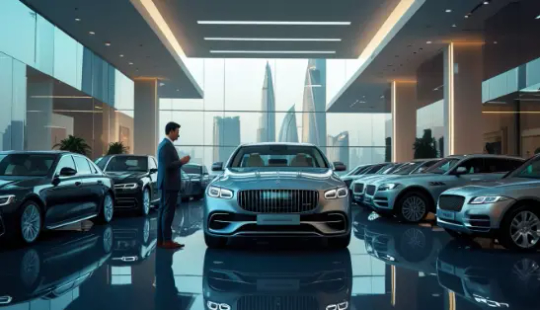
Gurugram, often referred to as the Millennium City, has long been synonymous with luxury, high-end lifestyles, and a passion for premium automobiles. Known for its modern infrastructure, thriving business hubs, and elite residential communities, the city is a hotspot for luxury car enthusiasts. At Motorpedia, we take pride in offering an extensive range of pre-owned luxury vehicles that cater to the city’s discerning buyers. Whether you're looking for a sleek sedan, a high-performance SUV, or an ultra-luxurious sports car, our inventory is stocked with some of the finest automobiles on the market.In this article, we spotlight the top luxury cars currently available in our Gurugram inventory, giving you an in-depth look at what makes each model special.
1. Mercedes-Benz E-Class: The Epitome of EleganceWhen it comes to combining sophistication, comfort, and cutting-edge technology, the Mercedes-Benz E-Class stands tall among luxury sedans. This model has long been a symbol of refinement and is an excellent choice for professionals, entrepreneurs, and those who appreciate the finer things in life.
Key Features:Plush leather interiors with ergonomic seatingAdvanced MBUX infotainment systemAdaptive cruise control and semi-autonomous driving capabilitiesPowerful yet efficient engine optionsAIRMATIC air suspension for an ultra-smooth rideWhether you choose a petrol or diesel variant, the E-Class delivers a seamless driving experience that is both exhilarating and comfortable. Browse our inventory for the latest models available in Gurugram.
2. BMW 5 Series: Driving Dynamics RedefinedFor those who crave a balance between luxury and performance, the BMW 5 Series is the ultimate choice. Renowned for its sporty design, precision engineering, and dynamic handling, this executive sedan is perfect for those who want their car to be as thrilling as it is elegant.
Why Choose the BMW 5 Series?
TwinPower Turbo engines offering incredible accelerationDriver-centric cockpit with a high-resolution infotainment displayAdaptive LED headlights for enhanced night visibilityGesture control for added convenienceExceptional safety features, including collision detection and lane assistBMW’s signature “Ultimate Driving Machine” philosophy is evident in the 5 Series, making it a top contender in the luxury sedan segment. Check out the options available in our Gurugram inventory.
3. Audi A6: Where Innovation Meets LuxuryThe Audi A6 is a true masterpiece in the world of luxury sedans, combining an elegant design with cutting-edge technology and supreme comfort. If you are someone who values advanced tech features and a smooth, responsive drive, this car should be on your radar.
to know more, visit...
https://themotorpedia.com/blog/luxury-cars-in-your-city-whats-in-our-inventory-right-now/281051bc69adc5df5f142cccf85d5ce4
0 notes